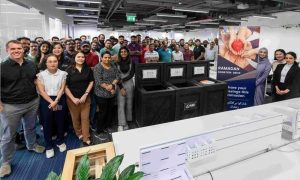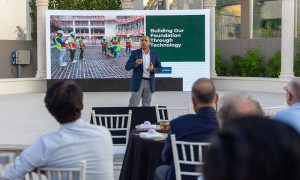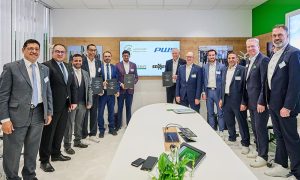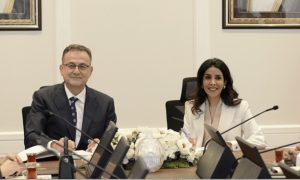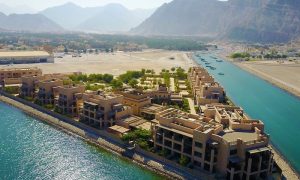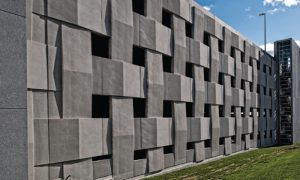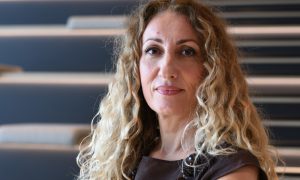Interview: Why ALEC has appointed an innovation manager
ALEC’s Hercu Viljoen, managing director, Related Businesses, and Imad Itani, innovation manager, on how the contractor is preparing for the future

Earlier this year, Kez Taylor, CEO of Dubai-based contractor ALEC, was asked by Big Project ME to identify key areas of the industry that construction companies would need to focus on. While he highlighted the need for collaboration and efficiency on projects, he particularly emphasised fostering a culture of innovation within companies.
Using his own firm as an example, Taylor pointed out that a culture that promotes innovation fosters an environment where employees are constantly looking for ways to improve efficiencies and performance.
“Everything should be simplified as much as possible, and improvements should be recognised and communicated throughout the business. Innovation is key and we have seen an appetite for new technologies and innovation across our industry,” he said at the time.
The men tasked with carrying out this vision and strategy for the company are Hercu Viljoen, managing director of Related Businesses, and Imad Itani, Innovation manager. The duo sat down with Big Project ME to discuss how innovation, which can be something of a nebulous concept, is helping one of the region’s leading contractors become a construction company comfortable in operating as a 21st-century business.
“I think it was about five years ago that we recognised the need to up the intensity of innovation in our company. It became a much more important function, so we set a task for one of our Evolve groups, which are the young engineers we train, to come up with a strategy for how our businesses can be more efficient in innovation,” says Viljoen.
“So that exercise came up with a strategy, and based on that, we had three or four key action points [to build around]. One of them was having a full-time manager, and so we appointed one at the time, and after a couple of years we felt the need to increase the level and make the innovation manager a more senior person within the company, and that’s why Imad was appointed.”
As innovation manager, Itani’s role is to create short- and long-term targets for the company and its employees, while also helping translate the company’s vision and strategies into objectives and tasks that will help it achieve its goal of becoming the most innovative construction firm in the region.
“When we started two years ago, we also identified barriers that were preventing us from being where we wanted to be, and worked towards finding solutions to solve those barriers,” he relates. “Communication was one of the main things. When we operate on projects, we tend to operate in silos – each project is separate and on its own, operating by itself. We wanted to find ways to collaborate more, communicate more. How do we reach the guys on-site, and how do they reach us? Do they feel that we’re supporting them? I come from site, and I understand what you expect on-site and how it feels to get support.
“We address communication through many means – through continuous communication, with different platforms for different people. One platform can work for some people, but another one is required for another set of people. For some people, we reached them through face-to-face meetings, but for others it was through emails, phone calls and different social platforms. We used different platforms and events to reach our people.
“Then, how do you teach people? How do you go from an idea towards implementation? That was the other thing, implementation. We put forward a set of long- and short-term ideas and said, these are important, and we need to deliver these projects, what do we need to do to deliver them? And then we assign individuals or teams to work on them, we give them the necessary support and we keep working with them till these ideas are delivered.
“The important thing is that once an idea is delivered, we give credit to the people who worked on it. What we found is that is once we implement more and more ideas, people will get more and more excited about them and you get more of them on board.”
Viljoen explains that one of the biggest obstacles during this initial implementation phase was changing the mindset of employees. People within the organisation were simply not ready or willing to change and break habits they had developed over many years.
However, both he and Itani say the innovation team and ALEC senior management didn’t try to force change on their employees; rather, they focused on encouragement and positive reinforcement, believing this approach would pay dividends in the long run.
“Innovation is about taking measurable risks and human nature is to avoid risk, but with innovation sometimes you have to test, and sometimes you have to fail. We are changing ALEC’s culture by telling people that it’s fine to take small risks, and we then take bigger risks as we implement more ideas and strategies,” adds Itani.
Viljoen asserts that ALEC senior management believes this approach is critical for the future survival of the company, and he urges the rest of the construction industry to follow suit.
“If we never act, then we are never going to survive. That’s why we’ve made innovation one of our values and that’s why we’re driving it from the top level, with people working on it full-time. Our industry is broken, the systems are broken, it’s archaic and it doesn’t function properly anymore, which is why so many projects finish late, and that’s why most of them are over budget. We believe that if we have a very clear strategy of implementing some of this new-age, innovative thinking, we could intersect in the future and really stand out as a contractor.”
A crucial element of this shift is to move ALEC towards adopting more digital technologies and systems as part of everyday work. Not only will this approach allow it to improve its core targets of communication and coordination, it will also allow the company to better prepare itself for a future that is rapidly becoming completely digital, Itani says. With data analysis now a major contributing factor to success in many other industries, he is keen for ALEC to be an early adopter in the regional construction industry.
“From day one, we have been telling people that if they cannot measure it, then they cannot manage it and consequently improve it. You need to start to record all the activities that you do, and then you can start to look and make sense of what you need to improve.
“The teams tell us where there are non-efficient activities, what is not productive enough, and we will look for ways to improve it. There are lots of opportunities available with technology to track, monitor and get all of this data, and get the variety needed to analyse it, work on it and then give suggestions to our people. We have been doing a number of initiatives and we will be doing more this year, in relation to data collection, analysis and then making the right decisions,” Itani says.
This approach has resulted in a staggering increase in productivity, he says, claiming that the increased figures range from as little as 10% to as much as 400%, just through the use of new equipment, software or products, or a new set of methodologies and techniques.
“Through different initiatives, we are seeing massive improvements that can go from 10% to 400%,” says Itani. “We are talking about 20-30% improvements just through our understanding. We select bottleneck projects and check what are the things that can be done to improve efficiency on a job. We work specifically on those bottlenecks and try and improve them and maximise efficiency.
“A typical example of how data can help us is by looking at vertical transportation on a project. That is a big bottleneck for any contractor. Imad and his team measure all the data – stoppage times, waiting times, movement times and all that. Just by analysing the data, we can then implement an efficiency strategy,” Viljoen says.
“We become lazy to see them [the bottlenecks] – they stare us in the face every day, but if we train our people to look with their eyes open, then those bottlenecks become apparent to us. People can come to us and say that there’s something on-site that’s happening which shouldn’t be happening. The more we try and train our people and have them come up with suggestions, the more these bottlenecks will be identified [and resolved].”
Encouraging employees to talk is a major part of the Innovation team’s remit, and because the construction industry is generally quite tight-lipped, Itani says creating that atmosphere of trust and openness is a crucial aspect of his job.
“In our industry, people don’t normally talk, but now they’re starting to talk more and they’re saying, ‘Listen, this is a problem.’ Before, people used to say, ‘This is a problem, let me hide it.’ Now, we want people to talk about the problems because then maybe we can fix them – and in most of the cases, we can. They can even fix the problems themselves, but they do need to talk about them.
“We are telling people to challenge why they should accept these problems, and then all these problems start to surface when they begin to challenge [these issues]. This is where their colleagues – maybe a guy on a similar project, for example – can give them advice because of something he’s tried before that’s worked. We want to connect people together to find solutions as a team.”
This willingness to share information and knowledge comes right from the top, Viljoen asserts, pointing out that company leadership consistently goes for training, with the emphasis on alignment and training.
“Alignment is the art of business. How do we align? How do we work together and how do we collaborate? That’s the first thing, that the message from the top is consistent – that we work together as part of our culture. That’s why we talk about culture [playing a major role].
“Then we have the forms of communication – we opened up an internal social media, as well as on-site forums, where people could communicate more openly. It’s very important too that people realise that no one is going to get fired for highlighting a problem – actually they might be rewarded for it! That attitude changes the mindset as well,” he adds.
Concluding the interview, Itani expands on the need for regular communication and its importance to ALEC. As people become more and more aware of the importance of ideas and of sharing those ideas, he believes the company will continue to see added value and growth, not just for itself but for the industry as a whole.
“Once people start to talk more about efficiencies, then they’re starting to talk the language that we want them to talk. This is what is important – that the word ‘innovation’ is repeated many times and that the message [permeates throughout the company]. We can start to see that as the years go by, the number of initiatives are increasing, that successful innovation is happening and that the company is growing. There is definitely a lot of added value to the company and to the industry.”
While he is aware that this isn’t a change that is going to happen overnight, Viljoen insists that the time has come for the construction industry to make a change in how it operates, and that it is crucial that ALEC be at the forefront of this change.
“Is the industry ready for the change? No, I don’t think so, but our company is. We are changing our mindset. Construction hasn’t changed for 50 or 60 years, but now the younger generation is coming in and is ready for that change. Now we look at the construction site with its boom cranes, concrete pumps, slabs, etc, and it will change.
“His Highness Sheikh Mohammed Bin Rashid Al Maktoum set the goal of having 25% of Dubai’s buildings being 3D-printed by 2030, and all of us thought then that it was an impossible task. Now we’re thinking that it’s very possible, if we just apply our minds.
“You don’t say that you want to change the culture tomorrow – it’s a process. And it’s the same with innovation. It’s a process of changing the mindset and it’s a journey. It’s a journey of modernising our industry, and I think that it will take a decade maybe, but this year we’re doing something. Next year it’ll be a little bit more, and then a little more the year after that,” he explains.
“It’s coming. The next five years are going to be extremely exciting, because our industry is going to transform itself.”
